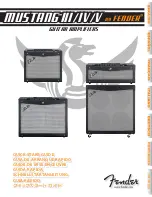
The Technical Stuff
__________________________________________________________
- 19 -
Despite the increased dynamic range, compression is especially important when recording digitally,
for two reasons: One, it helps ensure that the signal is encoded at the highest possible level, where
more bits are being used so that better signal definition is achieved. Secondly, it helps prevent a
particularly harsh type of distortion known as
clipping
—something that, ironically, is especially
egregious in digital recording, due to the inherent limitations of digital technology.
During recording, compression is customarily used to minimize the volume fluctuations that occur
when a singer or instrumentalist performs with too great a dynamic range for the accompanying
music. It can also help to tame acoustic imbalances within an instrument itself—for example, when
certain notes of a bass guitar resonate more loudly than others, or when a trumpet plays louder in
some registers than in others. Properly applied compression will make a performance sound more
consistent throughout. It can tighten up mixes by melding dense backing tracks into a cohesive
whole, can make vocals more intelligible, and can add punch and snap to percussion instruments
like kick drum and snare drum, making them more “present” without necessarily being louder. It can
also impart tonal coloration, making a signal warmer and fatter. Compression can even serve as a
musical tool, enhancing the sustain of held guitar notes or keyboard pads, or providing a snappier
attack to horn stabs or string pizzicato.
Input Signal and Threshold
The first and perhaps most significant factor in compression is the level of the input signal. Large
(loud) input signals result in more gain reduction, while smaller (softer) input signals result in less
gain reduction.
Threshold
is another important factor. It is a term used to describe the level at which
a compressor starts to work. Below the threshold point, the volume of a signal is unchanged; above
it, the volume is reduced. For example, if a compressor’s threshold is 0 dB, incoming signals at or
above 0 dB will have their gain reduced, while those below 0 dB will be unaffected.
In the LA-610, the Peak Reduction
knob controls both the threshold and the amount of input signal
being routed to the compressor circuit. As it is turned up (clockwise), the overall degree of
compression increases; as it is turned down (counterclockwise), the overall degree of compression
decreases. At the 0 (fully counterclockwise) setting, no signal enters the compression circuit, hence
no gain reduction.















































